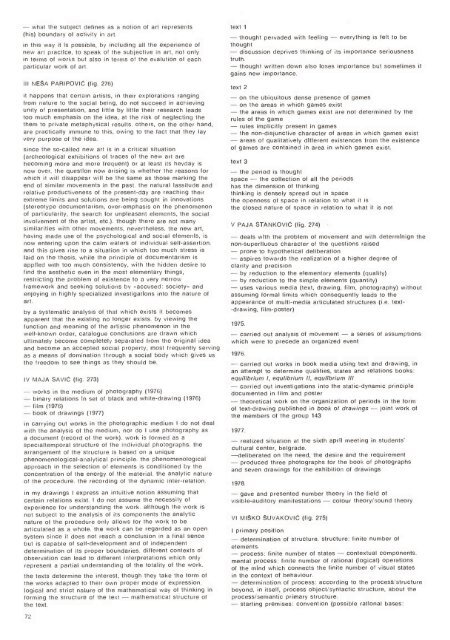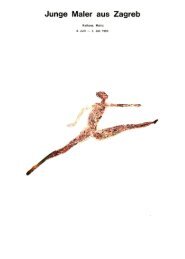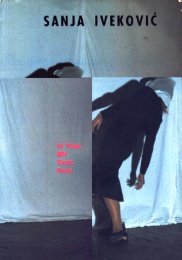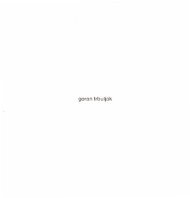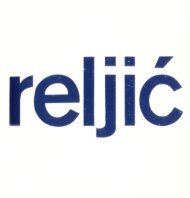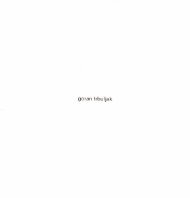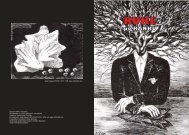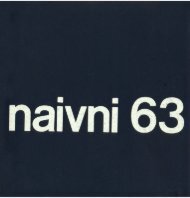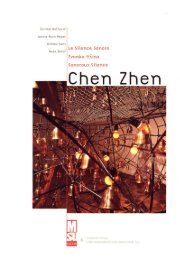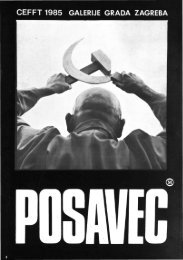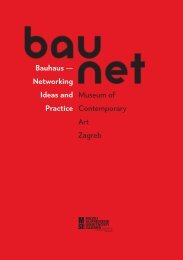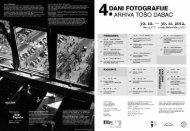The New Art Practice in Yugoslavia, 1966-1978
The New Art Practice in Yugoslavia, 1966-1978
The New Art Practice in Yugoslavia, 1966-1978
- TAGS
- practice
- yugoslavia
- www.msu.hr
You also want an ePaper? Increase the reach of your titles
YUMPU automatically turns print PDFs into web optimized ePapers that Google loves.
what the subject def<strong>in</strong>es as a notion of art represents<br />
(his) boundary of activity <strong>in</strong> art.<br />
<strong>in</strong> this way it is possible, by <strong>in</strong>clud<strong>in</strong>g all the experience of<br />
new art practice, to speak of the subjective <strong>in</strong> art, not only<br />
<strong>in</strong> terms of works but also <strong>in</strong> terms of the evalution of each<br />
particular work of art.<br />
III NEA PARIPOVIC (fig. 276)<br />
it happens that certa<strong>in</strong> artists, <strong>in</strong> their explorations rang<strong>in</strong>g<br />
from nature to the social be<strong>in</strong>g, do not succeed <strong>in</strong> achiev<strong>in</strong>g<br />
unity of presentation, and little by little their research leads<br />
too much emphasis on the idea, at the risk of neglect<strong>in</strong>g the<br />
them to private metaphysical results. others, on the other hand,<br />
are practically immune to this, ow<strong>in</strong>g to the fact that they lay<br />
very purpose of the idea.<br />
s<strong>in</strong>ce the so-called new art is <strong>in</strong> a critical situation<br />
(archeological exhibitions of traces of the new art are<br />
becom<strong>in</strong>g more and more frequent) or at least its heyday is<br />
now over, the question now aris<strong>in</strong>g is whether the reasons for<br />
which it will disappear will be the same as those mark<strong>in</strong>g the<br />
end of similar movements <strong>in</strong> the past. the natural lassitude and<br />
relative productiveness of the present-day are reach<strong>in</strong>g their<br />
extreme limits and solutions are be<strong>in</strong>g cought <strong>in</strong> <strong>in</strong>novations<br />
(stereotype documentarism, over-emphasis on the phenomenon<br />
of particularity, the search for unpleasant elements, the social<br />
<strong>in</strong>volvement of the artist, etc.). though there are not many<br />
similarities with other movements, nevertheless, the new art,<br />
hav<strong>in</strong>g made use of the psychological and social elements, is<br />
now enter<strong>in</strong>g upon the calm waters of <strong>in</strong>dividual self-assertion.<br />
and this gives rise to a situation <strong>in</strong> which too much stress is<br />
laid on the thesis, while the pr<strong>in</strong>ciple of documentarism is<br />
applied with too much consistency, with the hidden desire to<br />
f<strong>in</strong>d the aesthetic even <strong>in</strong> the most elementary th<strong>in</strong>gs.<br />
restrict<strong>in</strong>g the problem of existence to a very ncrrow<br />
framework and seek<strong>in</strong>g solutions by «accused: society. and<br />
enjoy<strong>in</strong>g <strong>in</strong> highly specialized <strong>in</strong>vestigations <strong>in</strong>to the nature of<br />
art.<br />
by a systematic analysis of that which exists it becomes<br />
apparent that the exist<strong>in</strong>g no longer exists, by view<strong>in</strong>g the<br />
function and mean<strong>in</strong>g of the artistic phenomenon <strong>in</strong> the<br />
well-known order, catalogue conclusions are drawn which<br />
ultimately become completely separated from the orig<strong>in</strong>al idea<br />
and become an accepted social property, most frequently serv<strong>in</strong>g<br />
as a means of dom<strong>in</strong>ation through a social body which gives us<br />
the freedom to see th<strong>in</strong>gs as they should be<br />
IV MAJA SAVIC (fig. 273)<br />
works <strong>in</strong> the medium of photography (1976)<br />
b<strong>in</strong>ary relations <strong>in</strong> set of black and white-draw<strong>in</strong>g (1976)<br />
film (1976)<br />
- book of draw<strong>in</strong>gs (1977)<br />
<strong>in</strong> carry<strong>in</strong>g out works <strong>in</strong> the photographic medium I<br />
do<br />
not deal<br />
with the analysis of the medium, nor do I use photography as<br />
a document (record of the work). work is formed as a<br />
specialtemporal structure of the <strong>in</strong>dividual photographs, the<br />
arrangement of the structure is based on a unique<br />
phenomenological-analytical pr<strong>in</strong>ciple the phenomenological<br />
approach <strong>in</strong> the selection of elements is conditioned by the<br />
concentration of the energy of the material, the analytic nature<br />
of the procedure. the record<strong>in</strong>g of the dynamic <strong>in</strong>ter-relation.<br />
<strong>in</strong> my draw<strong>in</strong>gs I express an <strong>in</strong>tuitive notion assum<strong>in</strong>g that<br />
certa<strong>in</strong> relations exist. I do not assume the necessity of<br />
experience for understand<strong>in</strong>g the work. although the work is<br />
not subject to the analysis of its components the analytic<br />
nature of the procedure only allows for the work to be<br />
articulated as a whole. the work can be regarded as an open<br />
system s<strong>in</strong>ce it does not reach a conclusion <strong>in</strong> a f<strong>in</strong>al sence<br />
but is capable of self-development and of <strong>in</strong>dependent<br />
determ<strong>in</strong>ation of its proper boundaries, different contexts of<br />
observation can lead to different <strong>in</strong>terpretations which only<br />
represent a partial understand<strong>in</strong>g of the totality of the work.<br />
the texts determ<strong>in</strong>e the <strong>in</strong>terest, though they take the form of<br />
the works adapted to their own proper mode of expression.<br />
logical and strict nature of the mathematical way of th<strong>in</strong>k<strong>in</strong>g <strong>in</strong><br />
form<strong>in</strong>g the structure of the text mathematical structure of<br />
the text.<br />
text 1<br />
thought pervaded with feel<strong>in</strong>g everyth<strong>in</strong>g is felt to be<br />
thought<br />
discussion deprives th<strong>in</strong>k<strong>in</strong>g of its importance seriousness<br />
truth.<br />
thought written down also loses importance but sometimes it<br />
ga<strong>in</strong>s new importance.<br />
text 2<br />
on the ubiquitous dense presence of games<br />
on the areas <strong>in</strong> which games exist<br />
the areas <strong>in</strong> which games exist are not determ<strong>in</strong>ed by the<br />
rules of the game<br />
rules implicitly present <strong>in</strong> games<br />
the non-disjunctive character of areas <strong>in</strong> which games exist<br />
areas of qualitatively different existences from the existence<br />
of games are conta<strong>in</strong>ed <strong>in</strong> area <strong>in</strong> which games exist.<br />
text 3<br />
the period is thought<br />
space the collection of all the periods<br />
has the dimension of th<strong>in</strong>k<strong>in</strong>g<br />
th<strong>in</strong>k<strong>in</strong>g is densely spread out <strong>in</strong> space<br />
the openness of space <strong>in</strong> relation to what it is<br />
the closed nature of space <strong>in</strong> relation to what it is not<br />
V PAJA STANKOVIC (fig. 274)<br />
deals with the problem of movement and with determ<strong>in</strong>ign the<br />
non-superfluous character of the questions raised<br />
prone to hypothetical deliberation<br />
aspires towards the realization of a higher degree of<br />
clarity and precision<br />
by reduction to the elementary elements (quality)<br />
by reduction to the simple elements (quantity)<br />
uses various media (text, draw<strong>in</strong>g, film, photography) without<br />
assum<strong>in</strong>g formal limits which consequently leads to the<br />
appearance of multi-media articulated structures (i.e. text-<br />
-draw<strong>in</strong>g, film-poster)<br />
1975.<br />
carried out analysis of movement a series of assumptions<br />
which were to precede an organized event<br />
1976.<br />
carried out works <strong>in</strong> book media us<strong>in</strong>g text and draw<strong>in</strong>g, <strong>in</strong><br />
an attempt to determ<strong>in</strong>e qualities, states and relations books:<br />
equilibrium I, equlibrium II, equlibrium III<br />
carried out <strong>in</strong>vestigations <strong>in</strong>to the static-dynamic pr<strong>in</strong>ciple<br />
documented <strong>in</strong> film and poster<br />
theoretical work on the organization of periods <strong>in</strong> the form<br />
of text-draw<strong>in</strong>g published <strong>in</strong> book of draw<strong>in</strong>gs jo<strong>in</strong>t work of<br />
the members of the group 143<br />
1977.<br />
- realized situation at the sixth april meet<strong>in</strong>g <strong>in</strong> students'<br />
cultural center, belgrade.<br />
deliberated on the need, the desire and the requirement<br />
produced three photographs for the book of photographs<br />
and seven draw<strong>in</strong>gs for the exhibition of draw<strong>in</strong>gs<br />
<strong>1978</strong><br />
gave and presented number theory <strong>in</strong> the field of<br />
visible-auditory manifestations colour theory sound theory<br />
VI MIKO UVAKOVIC (fig. 275)<br />
I primary position<br />
determ<strong>in</strong>ation of structure. structure: f<strong>in</strong>ite number of<br />
elements.<br />
process: f<strong>in</strong>ite number of states contextual components.<br />
mental process: f<strong>in</strong>ite number of rational (logical) operations<br />
of the m<strong>in</strong>d which connects the f<strong>in</strong>ite number of visual states<br />
<strong>in</strong> the context of behaviour.<br />
determ<strong>in</strong>ation of process: accord<strong>in</strong>g to the process structure<br />
beyond, <strong>in</strong> itself, process object syntactic structure, about the<br />
process semantic primary structure.<br />
start<strong>in</strong>g premises: convention (possible rational bases:


